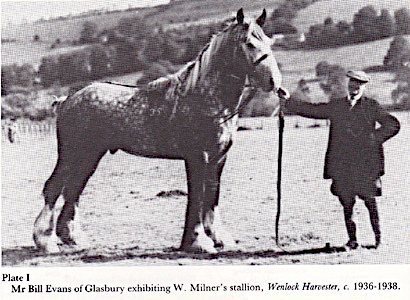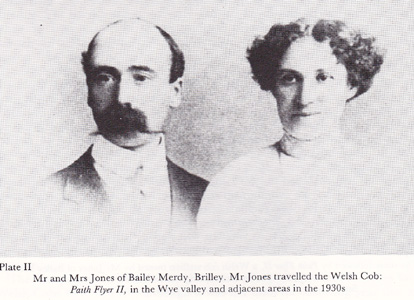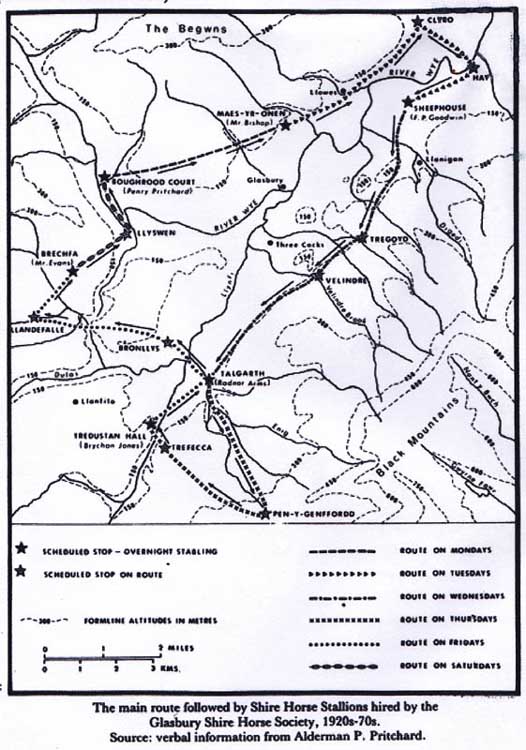

Introduction
Horses played a major role
in the transport system in Britain until, in the years following the conclusion
of the First World War, they were gradually ousted by motor vehicles.
In 1917, when the first reasonably complete equine census of Britain was
undertaken, there were 2,650,773 horses in the country, 1, 115,920 of
which were used for agricultural purposes (Chivers, 1976). Horse breeding
was therefore of great importance and a variety of attempts was made to
improve the quality of horses by subsidising stallions that travelled
the countryside during the breeding season, and that were available, at
a fee, for the service of mares. This paper describes some of the routes
followed by stallions that formerly travelled in Brycheiniog and adjacent
counties.
Travelling Stallions
During the horse breeding season,
which for non-thoroughbred stock extends normally from April until July,
stallions used to be led around the countryside in search of trade: of
mares to service. The origins of the system are unknown, but it certainly
existed as early as the fourteenth century in the Welsh borderlands (Chivers
1976). By the 19th century various agricultural societies were awarding
premiums (i.e. financial subsidies) to the owners of stallions that were
considered suitable and were made available for the service of local mares
(Lewis, 1984). In 1885 a show was held at Islington, in London, at which
premiums were awarded to the exhibitors of six thoroughbred sires who
were 'required to guarantee to tenant farmers the service of twenty mares
at the low fee of 50s each,' (H.S.B. II). From this beginning developed
the Hunters Improvement Society Premiums, which remain in existence in
the 1980s, although the Premium Stallions no longer travel the countryside;
instead, mares are now brought to the stallions, (Lewis, 1984). In addition
to the agricultural society and thoroughbred premiums, heavy horse hiring
societies developed in the nineteenth century. Chivers (1976) has shown
that they were initiated in Scotland in the 1830s, but the first non-
ephemeral hiring society to be established in England and Wales was the
Montgomeryshire District Entire Horse Association, founded in 1876. The
aim of these societies was to hire suitable draught stallions for use
on mares within the territory of each society. In 1914 the Board of Agriculture
granted £40 to each approved hiring society in England and Wales, and
these grants remained in existence until the Second World War.
In 1939 four heavy horse hiring societies existed in Breconshire: the Glasbury Shire Horse Society; the Breconshire Shire Horse Society; the Devynock Shire Horse Society; the Builth and Radnor Shire Horse Society. Figure One shows the location of heavy horse hiring societies in England and Wales in 1939. The route followed by the Shire Horse stallion hired by the Glasbury Shire Horse Society in c. 1970 is typical of the weekly itineraries of such heavy horses (Figure Two). Sometimes a society hired more than one horse, and possibly operated more than one route. Additionally, routes were changed from time to time according to the decisions of the committee of the society concerned. In 1935, for example, the Glasbury stallion was based at Boughrood Court but travelled on Monday to Aberedw and Builth, where it was stabled for the night at The Swan Hotel. On Tuesday it travelled to Hundred House, Batch's Common, Gladestry and to Newchurch for the night. On Wednesday the route continued via Rhosgoch and Painscastle to Clyro, where the stallion was stabled with Mr Dykes of Trenewydd, near Boatside. On Thursday the horse walked to Clyro, Hay (where it was fed at The Black Lion), Llanigon and Talgarth (where it was stabled for the night at The Radnor Arms). On Friday the route continue to Bronllys and Llandefalle, returning to Boughrood Court via Llyswen on Saturday. The horse rested at Boughrood Court on Sunday. Miah Evans of Aberedw led the stallion around this route throughout the season. (M. Evans, personal communication).

.